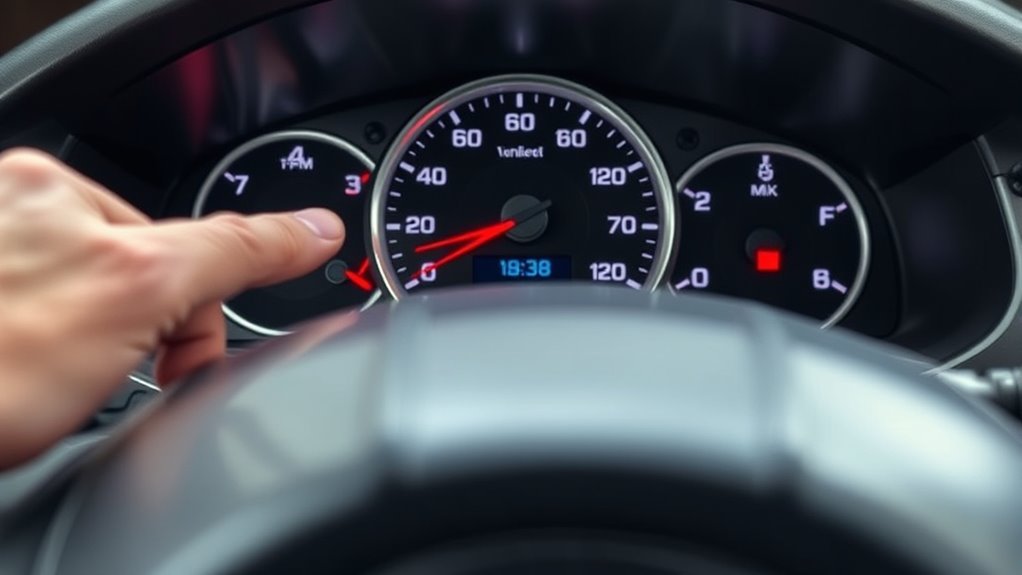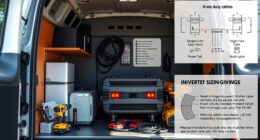After disconnecting your battery, you’ll need to restart your engine and let it idle for about 10-15 minutes without pressing the accelerator or turning on accessories. This allows your ECU to relearn the proper idle settings. Make sure the vehicle is on a level surface and the engine is warmed up to normal temperature. If you follow these steps, your engine should smooth out. Continuing will reveal more tips to guarantee a successful idle relearn process.
Key Takeaways
- Reconnect the battery securely, start the engine, and let it idle without accelerator input.
- Allow the engine to warm up to normal operating temperature over 10-15 minutes.
- During warm-up, avoid turning on accessories like A/C or headlights to prevent interference.
- Observe for stabilized idle speed; ECU will relearn idle parameters during warm-up.
- If issues persist, consult vehicle manual or a mechanic for specific reset procedures.

When you disconnect your vehicle’s battery, the engine control unit (ECU) may lose key settings, causing idle issues. This is because the ECU relies on stored data to manage various parameters, including idle speed. Once the power is cut, these settings reset, forcing the ECU to relearn the correct idle parameters once power is restored.
Disconnecting the battery resets the ECU, causing idle issues until it relearns proper settings.
If you notice your engine idling roughly, stalling, or running unevenly after reconnecting the battery, performing an idle relearn process can resolve these problems and restore smooth operation.
The first step is to ensure your vehicle is parked on a level surface and the engine is turned off. After reconnecting the battery terminals securely, start the engine and let it idle without pressing the accelerator. Allow the engine to warm up to its normal operating temperature, which can take several minutes.
During this warm-up period, the ECU begins to reestablish optimal idle settings based on the engine’s current conditions. You might notice the idle speed fluctuating slightly—that’s normal as the ECU adjusts.
While the engine is idling, avoid turning on accessories like the air conditioning, headlights, or other electrical loads. These devices increase engine load and could interfere with the ECU’s ability to properly relearn the correct idle speed.
Some vehicles might require specific procedures, such as turning on the AC or headlights during the idle process, to help the ECU calibrate properly. Consult your vehicle’s manual or a professional if you’re unsure about any special steps.
In many cases, just letting the engine idle for about 10 to 15 minutes is enough for the ECU to complete its relearn process. During this time, the ECU “listens” to the engine’s response and makes necessary adjustments to the idle speed.
If your vehicle has a drive-by-wire throttle system, it’s especially important to perform this idle relearn, as the throttle body needs to recalibrate. Some newer models might have a dedicated reset or relearn procedure that involves turning the ignition on and off in a specific sequence, so always check your owner’s manual for precise instructions.
Once the engine reaches its normal operating temperature and the idle stabilizes, you should notice smoother engine performance. If you’re still experiencing rough idling or stalling after the process, double-check all connections and consult a mechanic.
Properly performing an idle relearn ensures your vehicle’s ECU has the correct data, leading to better engine performance, improved fuel efficiency, and a smoother ride.
Frequently Asked Questions
How Long Does the Idle Relearn Process Typically Take?
The idle relearn process usually takes about 2 to 3 minutes. During this time, you’ll need to start your vehicle and let it idle without applying the accelerator.
It’s important to keep the engine at normal operating temperature, so avoid turning off the engine prematurely. Once the relearn is complete, your vehicle’s idle should stabilize, improving overall performance and fuel efficiency.
Can I Perform the Idle Relearn Manually Without a Scanner?
Can you perform the idle relearn manually without a scanner? Think of it like teaching your car to breathe again—it’s possible but tricky.
Some vehicles allow you to do a manual idle relearn by following specific procedures, such as turning the ignition on and off, and letting the engine idle for a few minutes.
But for best results, using a scan tool guarantees the process is precise and safe, saving you time and hassle.
Will Disconnecting the Battery Affect Other Vehicle Systems?
Yes, disconnecting your battery can affect other vehicle systems. When you do this, your radio presets, clock, and sometimes even your alarm system may reset.
Modern vehicles with advanced electronics might also lose diagnostic codes or require reprogramming. To avoid issues, make sure you’re prepared to reconfigure settings afterward and consider using a memory saver device to protect sensitive systems during the battery disconnect.
Is Idle Relearn Necessary After Replacing the Alternator?
You might think replacing the alternator doesn’t require an idle relearn, but it often does. When you replace the alternator, your vehicle’s ECU may need to recalibrate idle settings for maximum performance.
Skipping this step can lead to rough idling or stalling. To guarantee your vehicle runs smoothly, it’s best to perform an idle relearn procedure, which helps the ECU adjust to the new alternator and maintain proper idle speed.
Are There Risks of Damaging the ECU During Idle Relearn?
Yes, there’s a small risk of damaging the ECU during an idle relearn if you don’t follow the proper procedures.
If you disconnect the battery or replace components incorrectly, it could cause electrical issues or miscommunication with the ECU.
To minimize risks, guarantee you follow the manufacturer’s instructions carefully, perform the relearn process correctly, and avoid abrupt power interruptions.
Proper procedures help protect your ECU and ensure smooth engine performance.
Conclusion
After disconnecting the battery, you need to perform an idle relearn to restore your vehicle’s efficiency. Follow the steps carefully, stay patient, and keep the engine running smoothly. Reset the system, monitor the idle, and make sure everything functions properly. By doing so, you guarantee your car’s performance, protect your engine, and maintain your driving experience. Remember, patience, precision, and persistence are key to a successful idle relearn after a battery disconnect.









